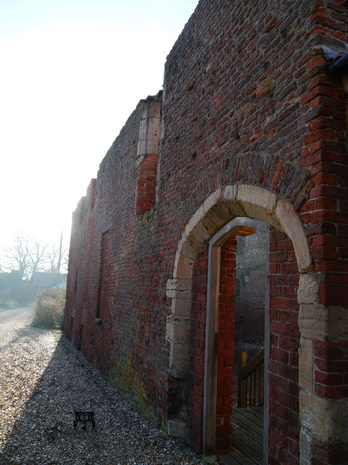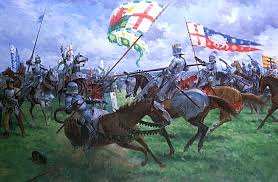I will be definitely keeping it and having it framed despite the fact it was the place where Richard Duke of York’s head was placed following the Battle of Wakefield.
|
This is a print of an engraving by John Raffe of Micklegate Bar in York from a painting by English artist William Westall. Westall is most famous for the work he produced in Australia. In 1800 he was asked by Joseph Banks to serve as a landscape and figure painter aboard HMS Investigator, under Lincolnshire born Matthew Flinders. By 1829 Westall was back in England working for publisher Rudolf Ackermann. Westall’s illustrations were used in educational publications and he also produced over a hundred drawing for Great Britain Illustrated from where I believe this print originates.
I will be definitely keeping it and having it framed despite the fact it was the place where Richard Duke of York’s head was placed following the Battle of Wakefield.
0 Comments
On this day in 1460, the death of one of my all-time heroes, Richard, Duke of York. In the afternoon of the 30th December 1460, the Battle of Wakefield took place, this battle brought an end to the lives of Richard, Duke of York and his second eldest son Edmund, Earl of Rutland. In the October of 1460, the Act of Accord acknowledged the Duke of York as the heir to Henry VI and effectively disinherited Henry's son Edward. It was hoped that this agreement would put an end to the political tension that had caused so much trouble in previous years, but it was not to be. The Act of Accord naturally left the Lancastrian's foaming at the mouth, many were angry that the act had swept the rules of primogeniture under the carpet, a rule that had protected the rights of the noble family for decades, without which there would be chaos. Many Lancastrians rallied to the cause resulting in a number of revolts occurring in the country with Henry's queen, Margaret of Anjou, at its helm. The first serious clash happened in Yorkshire, just over two months after the Act of Accord was signed. On the 9th of December, leaving his wife and younger children in London, Richard marched north with an army to waylay Margaret. The Duke of York, now heir apparent made his way towards Sandal Castle to meet the forces of the opposing army on the fields you see in the above images, even though York's force outnumbered the Lancastians by two to one the battle went the way of Lancaster. Richard Duke of York died among his men that day at Wakefield, a noble but untimely death you could say, his second son, Edmund Earl of Rutland died that day too only his death was taken in vengeance. David Hume in his History of England writes of York's death "The Duke himself was killed and beheaded, and when his body was found among the slain, the head was cut off by Margaret's orders and fixed on the gates of York, with a paper crown upon it, in derision of his pretended title.' As the country woke to welcome in the new year, the residence of the City of York rose to find the Duke of York’s head had been placed on a pike at the very top of Micklegate Bar. In a pitiless act of humiliation it was plain to see what Margaret of Anjou was saying when she ordered a paper crown placed on his head.
Fitted to a metal gate on the steps of York's city wall at Micklegate Bar is this roundel made in Fetter Lane by C Dearlove.
Dearloves were whitesmiths, a company who worked with white iron, that is tin, the workers at Dearloves would have finished or polished the tin ready for it to be painted and decorated as you see with this fine emblem of York, the White Rose. Fetter lane forms part of medieval York, it runs to the south of Micklegate Bar and joins Skeldergate which runs parallel to the River Ouse. Incidentally, the word fetter refers to a chain or manacle, made out of iron that was used to restrain a prisoner around the ankles. I wonder if Richard Duke of York and his son Edmund were restrained with such manacles before their decapitated heads ended up on Micklegate Bar in 1460. You needn't worry, Dearloves were not involved in such a barbaric practice, the company worked in York during the nineteenth and twentieth centuries. King Edward IV became unwell in the Easter of 1483 and false news of his death and uncertainty as to who would take the throne was the talk in the major towns and villages of the realm. The city of York had received news on the 6th April 1483 (three days early) that the king was dead, convinced of this fact the city held a Requiem Mass the following day. Uncertainty about Edward’s replacement was also a concern, especially in the county of Lincolnshire. John Gigur, warden of Tattershall College in Lincolnshire, wrote to the Bishop of Winchester: "I beseche you to remember in what jeopardy youre college of Tateshale stondyth in at this day; for nowe oure Soveren Lord the Kyng ys ded we wete not hoo schal be oure Lord nor hoo schal have the reule aboute us."
My photographs show all of what remains of Tattershall's Old Collage, where John Gigur wrote to the Bishop of Westminster in 1483 voicing his concerns. This is a question with no easy answer, but it can be looked at in a number of ways. If we consider the Wars of the Roses began in 1455 with the first battle of St Albans we should look at the Battle of Tewkesbury as the final battle in these wars. The origins of these battles had their roots in the rivalry between the Duke of Somerset and the Duke of York. Following King Henry VI 'regaining his senses' Edmund Beaufort was given back his former post. To make matters worse, Beaufort was also given the captaincy of Calais which really rubbed York up the wrong way, eventually, it came to blows at St Albans. You could say that the following fifteen battles, not including Bosworth and Stoke, were just a continuation of this, although there was far more to it than that. The beginning of the end was the death of Henry VI's son Edward at Tewkesbury, followed seventeen days later by Henry himself. You could that say the Wars of the Roses did indeed end at Tewkesbury. On the other hand, if you consider, like I do, the Wars of the Roses began or at least the seeds were set on the 8th June 1376 with the death of Edward III's heir Edward the Black Prince. The fallout from the Black Prince's death cannot be underestimated. A boy king, an influential and 'lustful' uncle, an illegitimate brood and a usurper, lead you to follow two lines. Firstly that of the usurper, where you end up at Henry VI and Margaret Beaufort/Henry Tudor and secondly, if you follow the line of John Beaufort, Gaunt's illegitimate son, you get Margaret Beaufort and Henry Tudor. Which line you follow makes no difference you will end up with events of 1483 to 1485. With all that in mind, you will have to say that the Wars of the Roses ended at Bosworth. Two years after Bosworth the armies of York and Lancaster met again at Stoke Field in Nottinghamshire. Henry VII found himself in the same position as that of Richard III defending his crown and facing a rebel army who were intent on placing a Plantagenet on the throne, albeit an impostor. Lambert Simnel, a claimant to England's throne posing as Edward, Earl of Warwick, was crowned in Dublin by John de la Pole and Francis Lovell. With a Plantagenet claimant as their figurehead, only Henry VII stood in their way. John de la Pole died on the battlefield, Lovell's body was not among the dead, but his days were numbered. This battle effectively wiped out the last of the Yorkist rebels, enabling Henry VII to establish the Tudor dynasty virtually unchallenged, on the battlefield at least. Did the Wars of the Roses end with the Lancastrian victory at Stoke Field? What is the answer then Tewkesbury, Bosworth or Stoke? |
Categories
All
Archives
May 2024
|

















 RSS Feed
RSS Feed
